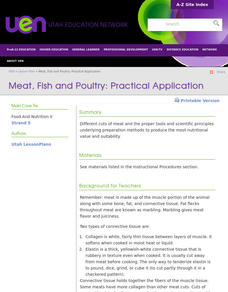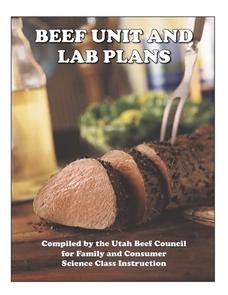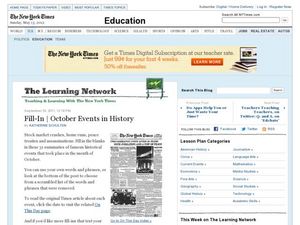Curated OER
Meat, Fish and Poultry: Practical Application
A note-taking outline is given to learners which covers meat composition and quality, types of meat and storage, and cooking meat. By viewing pictures they learn to identify cuts of meat or poultry products. They discuss inspection and...
Curated OER
Meat, Poultry, Fish, Eggs: Constructing and Maintaining
Students investigate meat as a source that provides protein, iron and nutrients in the diet. They identify types of meat and their sources, complete a market survey, conduct a fried egg experiment, and prepare various recipes that...
Curated OER
Meat Test
Students explore basics of meat, meat cookery, and preparation skills and techniques in safe handling procedure. Students state qualities or advantages of casserole, identify parts of casserole, food ingredients, function of...
Curated OER
Meat: Using the Correct Word
In this word choice activity, 5th graders complete 10 sentences about meat vocabulary, then click the button to see the correct answer.
Curated OER
EGG MAZE: COUNTING BY TWOS, THREES AND FIVES
Students successfully count by twos, threes and fives, using pictures of eggs and poultry as points of interest. They orally review the types of counting (twos, threes, or fives). Students are introduced the idea of a dozen eggs.
Curated OER
Meat, Poultry, Fish, Eggs: Constructing and Maintaining
Meat as a food source to provide necessary complete protein, iron, and other nutrients in the diet. Identify and prepare meats and/or poultry product(s). National Standard 14.3.3
Utah Beef Council
Beef Unit and Lab Plan
What are the proper methods for cooking various cuts of beef? What are some basic rules regarding meat food safety? Here you'll find 10 lab plans with a variety of beef cookery activities, perfect for a home economics or cooking course.
Curated OER
A Lucky Break
Students complete activities where they identify and decipher common phrases that are related to poultry and then cook drumsticks as a class. In this poultry lesson plan, students also read the history of the chicken and create idioms.
Curated OER
A Meat By Any Other Name. . .
Students, using a New York Times article as a springboard, discuss how food reflects different aspects of a culture and reasons why cultural differences in food are seen as bizarre or, oftentimes, cruel by members of other societies.
Curated OER
Our Friends or Foes
For this living organisms worksheet, 6th graders choose the multiple choice answer to 10 questions. Students then read and answer 10 statements as true or false and fill in the blanks to 5 statements.
Curated OER
A Lucky Break
Explore idioms with a chicken theme! Consider doing these activities prior to Thanksgiving, as there's a section about wishbones! First your youngsters will match a short list of idioms with their meanings. Then, give each learner the...
ProCon
Vegetarianism
What do Mike Tyson, Ellen DeGeneres, and Paul McCartney have in common? They're all famous vegetarians. Using the resource, scholars learn about the pros and cons of eating a vegetarian diet. They read a fascinating history of...
Curated OER
PICTURE PERFECT PYRAMID
Middle schoolers create a model of the USDA's Food Pyramid Guide, using shoe boxes. They bring an assortment of shoe boxes from home. Students are given a copy of the "Food Guide Pyramid." They wrap boxes for the bread group in white,...
Curated OER
Measuring Techniques - Level I
Demonstrate food preparation techniques of salads, soups, casseroles, breads, meats, poultry and pastries.
Curated OER
Food Groups
For this food groups worksheet, learners choose two words from the word list that belong in each of 7 food group categories. The groups are: dairy, poultry, grains, proteins, vegetables, fruits and junk food.
Curated OER
PECKING OUT RATIOS
The student will practice writing ratios as fractions, using poultry-related illustrations as visual representations of the problems.1. Review the definition of a ratio and how to write ratios as fractions. If possible, use
groups of...
Curated OER
Hot Off the Grill
Students read an article about humans getting sick from eating improperly cooked meat. In groups, they cook a hamburger patty and when they believe it is done, they check the temperature with thermometers. They record their temperatures...
Choose My Plate
My Daily Food Plan (18+ years old)
Manage your calorie intake with a daily food plan journal. After reviewing a reference sheet with suggested amounts of each food group based on a total calorie pattern, learners can jot down what foods they have eaten during the day as...
Curated OER
Food Pyramid Activity
In this food pyramid learning exercise, students fill in their choices in each of the food categories and estimate amounts eaten, then write their goals for food and activity for "tomorrow."
Curated OER
Food Pyramid
Students construct food pyramids by painting shoe boxes and using them to respresent different food groups. They cut out and paste pictures of the respresentative foods for the groups on the box sides. They compare their diets to the...
Curated OER
An International Dinner Table
Students investigate the origins of several crops eaten in the United States today. The facto0rs that influence consumer choices and the influences on the American population as to eating preferences are discussed in this lesson.
Virginia Polytechnic Institute and State University
Lesson Plan: Omelet Cooking Principles
Although designed for a foods lab, the information in this resource might be just the thing for your own recipe notebook. Illustrated, step-by-step directions for making the perfect omelet, egg-citing puzzles, games, and even...
Curated OER
Fill-In - October Event in History
A lot has happened in the month of October in the past 100 years or so. Kids fill in the blank for 31 events, each of which occurred on a day in October. Each event can be found in a New York Times article from the past 100+ years....
Utah Education Network (UEN)
Recipe Terminology Hunt
As your young learners develop into cooking enthusiasts, ensure their success in creating their next culinary masterpiece by preparing them to read and understand basic recipe terminology.

























